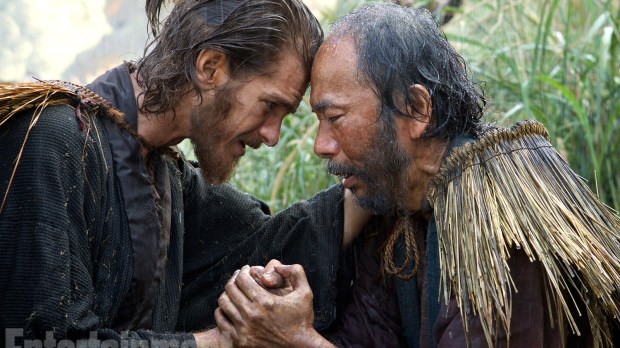Adapting Silence, a 1966 book about 17th century Jesuit missionaries, has been a passion project percolating in Martin Scorsese’s mind for decades. For a while, it looked like the film would never get done. But with the release of a full cast, a first still, and a brand new essay and storyboard courtesy of The Film Stage, Scorsese’s Silence is well on its way to its scheduled 2016 release.
The novel was written by Shusaku Endo, a little-known writer who was known as the “Japanese Graham Greene.” Both had a knack for gripping dramas, and both were united over East and West by a common Catholic heritage that informed their work – not as a means of proselytizing or smuggling in artificial moral lessons, but as a framework for unraveling human weaknesses and contradictions. “Our interest’s on the dangerous edge of things,” Greene liked to say, quoting Browning. “The narrow boundary between loyalty and disloyalty, between fidelity and infidelity, the mind’s contradictions, the paradox one carries within oneself.”
With Silence, Endo draws us back four centuries into a Japan where Christian converts are tortured and killed en masse – and along the way, contemplates the “narrow boundary” between believing in and questioning God, between the knowledge of faith and the problem of evil. (The new cover design from Picador says it all.)
That tension jumped out at Scorsese, who said that Silence has given him “a kind of sustenance that I found in only a very few works of art”. In an early forward for the novel, he wrote:
“How do you tell the story of Christian faith? The difficulty, the crisis, of believing? How do you describe the struggle? There have been many great twentieth century novelists drawn to the subject – Graham Greene, of course, and François Mauriac, Georges Bernanos… [Endo] understood the conflict of faith, the necessity of belief fighting the voice of experience. The voice that always urges the faithful – the questioning faithful – to adapt their beliefs to the world they inhabit, their culture… That’s a paradox, and it can be an extremely painful one: on the face of it, believing and questioning are antithetical. Yet I believe that they go hand in hand. One nourishes the other. Questioning may lead to great loneliness, but if it co-exists with faith – true faith, abiding faith – it can end in the most joyful sense of communion. It’s this painful, paradoxical passage – from certainty to doubt to loneliness to communion – that Endo understands so well, and renders so clearly, carefully and beautifully in Silence.”
The newly released Approaching Silence features a second essay from Scorsese that elaborates on the power of the story and how it will play out on film:
Endo’s novel confronts the mystery of Christian faith, and by extension the mystery of faith itself. Rodrigues learns, one painful step at a time, that God’s love is more mysterious than he knows, that He leaves much more to the ways of men than we realize, and that He is always present … even in His silence. What role am I playing, wonders Rodrigues? Why am I being kept alive? When will my martyrdom arrive? Of course, it doesn’t. Which means that he will be playing a role that is very different from the one he expected to play. He will not be following in the footsteps of Jesus. He will be taking a less revered path, and therefore playing a very different role. This is the most painful realization of all. How do I translate the last pages of the novel, as abstract as Moby-Dick or The Idiot, into images and actions? So how do I film these interior sensations and realizations and emotions? How do I make the mystery of faith, and the ways of God, cinematically present? The answer is in making the movie — going to Taiwan, working with the actors and the cameraman and the production designer, shooting, and then putting it together in the editing room, adding a frame here and taking one out there, mixing the sound, timing the color, and deciding that it’s finished. But on another level, that answer lies within the cinema itself, and its way of pointing us toward what we cannot see.
If Scorsese is right, then the journey of this story from the written word to the big screen is itself a hint at the “slow work of God”. With the first Jesuit pope now leading the Catholic Church, and a global war on Christians reaching crisis proportions across the world, the twenty-year delay may have been more providential than problematic, and Silence might end up being the most important film of Scorsese’s career.
WATCH THE TRAILER: it’s breathtaking!
Matthew Becklo is a husband and father, amateur philosopher, and cultural commentator at Aleteia and Word on Fire. His writing has been featured in First Things, The Dish, and Real Clear Religion.

